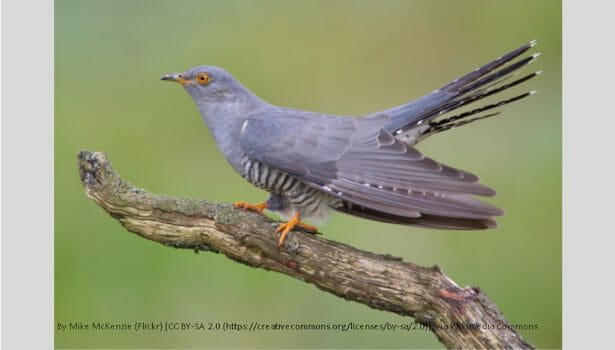Biodiversity Group Bird of the Month: The Cuckoo
The cuckoo is about the same size as a dove with blue grey upper parts, head and chest and dark horizontal barring underneath. In late April or early May the cuckoos arrive having spent the winter in central and southern Africa. Only the male makes the distinctive ‘cuckoo’ sound using it to claim his territory, attract a female and defend her throughout the summer. The female sets up her own territory and then watches and waits. Timing is crucial if her egg is to be accepted; too early and the host bird will be suspicious and eject it, too late and it will be left unhatched as the host birds start feeding their own young. Once the cuckoo chick has hatched it uses its flat back to lever the other chicks and eggs out of the nest. It then starts its begging call which is very fast, mimicking a whole brood of chicks and so encouraging the hosts to provide as much food for one mouth as it would for many. The cuckoo chick fledges after about 19 days and is then fed for another 2 weeks. By now it is full sized and the host bird, which is a lot smaller, will sometimes perch on its back to feed it. The cuckoo is on the red endangered list. In the last 25 years the population has declined by more than 70%. There is still some uncertainty as to why but it may be a decline in the number of host birds, a shortage of moth caterpillars, milder springs resulting in the caterpillars being around earlier and the Sahara desert, which is on their migratory route and already 1,200 miles across, getting even larger.
Did You Know?
- The cuckoo shakes the toxins out of its favourite food, the hairy caterpillar, before eating it.
- A cuckoo tagged by scientists a few years ago flew 60,000 miles in 3 years
- On average the cuckoo lays 8 eggs in 8 different nests but as many as 25 have been recorded.
- The female chooses the same host species as the one that raised her and can lay blue, brown, green or grey eggs with a variety of spots and patterns.
- An evolutionary race has taken place between the cuckoo developing near identical eggs to its host and the host recognising an alien egg. The brambling rejects 90% of eggs even though, over time, the cuckoo’s eggs have become very similar. Eggs laid in a dunnock’s nest, however, are nothing like a dunnock’s but are rarely rejected. Some think this is because the dunnock is a fairly new host species in evolutionary terms.
- Whilst studying the interaction between the cuckoo and its hosts Nick Davies, Professor of Behavioural Ecology in the Department of Zoology at Cambridge University, found that cuckoos using reed warbler’s nests recognised the warning call of the adult reed warblers, stopped their begging calls and crouched in the bottom of the nest.
A verse learnt at Aynhoe School:! The cuckoo comes in April. Sings his song in May. Chips his tune in the middle of June and in July he flies away. (Chips? He only says “Cuck” )

